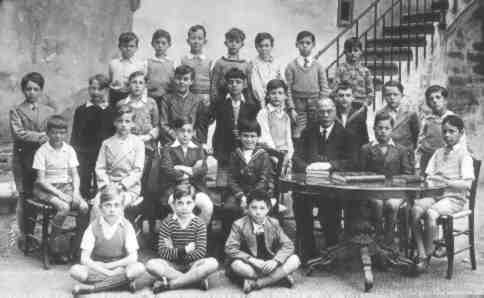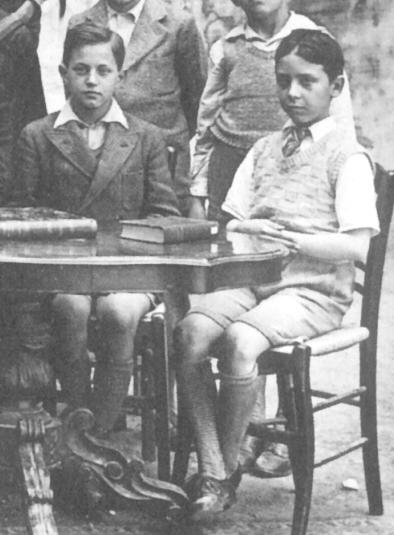
Figure 1.--Septième was the seventh or the youngest of the junior forms. The boys are about 8 or 9 years old. All of the boys appear to be wearing short pants, except for one of the boys wearing sailor suits.

This photograph shows Septième, the youngest of the junior forms at the Ecole libre Saint-François Régis about 1935. Almost all of the boys wear short pants, but only some wearsuits. A few boys wear sailor suits which were still popular boys clothes in France.
I am not sure what kind of school the boys entering Septième at Saint-François came from, but am looking into it.
Saint-François Régis was called an Ecole Libre which would now be a primary school. The Ecole Libre Saint-François Régis, however, in 1935 had both junior and senior forms. Septième or seventh was the first or entry level form at the school for the younger boys. They look to be about 8 or 9 years of age.
The boys in Septième appear to be all wearing short pants and kneesocks, except for a boy in a blue sailor suit who wears long pants. The Septième boys dress more casually than the boys in the more senior forms. A few boys wear suits, but most wear sweaters without jackets. One boy even wears a smock. This looks to be a good reflection of what French boys at the time were wearing.
French boys in the 1930s were still commonly wearing smocks to school. Presumably, many of the boys at their previous school would have commonly worn smocks to school. Coming to Saint-François, however, as the older boys did not wear smocks, the younger boys probably did not want to wear them either. It is possible that the boys took off their smocks for the photograph, but more than likely smocks were not very common. There is one boy wearing a smock. It is a dark, blue or black smock, and appears to be the back-buttoning style that was commonly worn by French schoolboys at the time. The fact that he has not taken his smock off suggests that the other boys were not wearing smocks and had removed them for the photograph. As was common in France, boys did not wear smocks with large white collars and bows as was the case in many Italian schools.
Sailor suits were still popular French boys wear in the 1930s, although the style had declined significantly from the 1920s. A few boys in the junior form wear sailor suits. In Septième there are two boys wearing sailor suits. They are both blue suits, but styled differently. One of the boys wears a long pants suit--the only longs visible in the form photograph. It is not clear what kind of pants the other boy is wearing. I am not sure what the boys thought about their sailor suits. The fact that only two boys in the form are wearing them suggests that they were not overly popular with these boys, perhaps because none of the older boys at their school wore them. One wonders if wearing long pants with sailor suits made them more or less popular with the boys. Boys generally like to wear what their buddies are wearing, so wearing both a sailor suit and long pants may have made them feel out of step with the others.
Only six of the boys are wearing suits or at least sports jackets for the photograph. Even fewer of these boys mightbhave worn suits had it not been the day for their class photograph. The suits and jackets tend to have large lapels, several are double breasted.
Ties were not commonly worn by these boys. Only one of the boys in suits or jackets wears a tie, but two boys in sweaters are wearing them. One boy with a jacket, the boy in the front row, wears a little bow. He can be seen along with the boy in the sailor suit (figure 3). Most boys wear the casual-looking open collar style.
Sweaters were very popular with these boys. Most of the boys wear them, both the sleeveless and and sleeve style. A variety of patterns are worn. There are square and "v" neck sweaters and one with a zip closure. Only a few boys wear shirts without sweaters. Several of the boys wearing suits or jackets also wear sweaters.
All of the boys except one of the boys in sailor suits appear to be wearing short pants. It is not possible to tell what all of the boys are wearing, but except for the other boy in sailor suit, they are almost all probably wearing shorts. The other boy in the sailor suit probably has long pants, but sailor suits were also made with shorts so it is possible that he also is wearing shorts. Most of the shorts apper to be knee length. One boy in a light double breasted suit, however, appears to be wearing shorter cut shorts. Some of the other boys have quite long shorts.

Figure 5.--Most of the boys appear to be wearing knee-length shorts. A few boys have shorter, or like one of these boys, quite long shorts. |
All of the boys in short pants are wearing kneesocks. Mostly they are plain light colored kneesocks, but a few have patterned kneesocks. Kneesocks were still very common in France. By the 1940s they were becoming more seasonal, worn during the cooler months. It seems in the 1930s, however, that they were commonly worn year round.
All of the boys appear to be wearing Oxford-type lace up shoes. None of the boys are wearing sandals which were commonly worn by younger French boys.
Related Chronolgy Pages in the Boys' Historical Web Site
[Main Chronology Page]
[The 1900s]
[The 1910s]
[The 1920s]
[The 1930s]
[The 1940s]
[The 1950s]
[The 1960s]
Related Style Pages in the Boys' Historical Web Site
[Return to the Main Saint-François page]
[Main school uniform page]
[Main country page]
[Long pants suits]
[Short pants suits]
[Socks]
[Eton suits]
[Jacket and trousers]
[Blazer
[School sandals]
